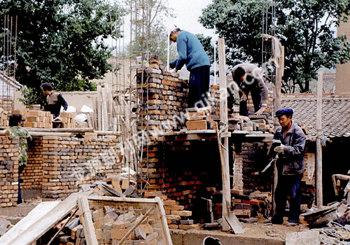Reconstruction from the Ground Up
By staff reporter LU RUCAI
On May 12, 2008, an earthquake registering eight on the Richter scale struck Wenchuan County in Sichuan Province. The massive quake also had an impact on neighboring areas, such as Longnan City in Gansu Province. Although there were no reports of heavy casualties in Gansu, the disaster still left 5 million people homeless. Over 1.3 million houses, mostly of wood and clay, collapsed in 10 quake-hit cities and prefectures. Cave dwellings were also highly vulnerable in the ruinous quake. In Longnan City alone, 850,000 houses fell down. Local residents are working intensely to rebuild their homes.

It takes over eight hours to drive from Gansus provincial capital Lanzhou to Longnan City, which was hit hardest in the province by Mays earthquake. The winding mountain road looked crowded due to destruction of some sections and increasing numbers of heavy-duty trucks loaded with construction materials.
In Longnan there were signs of the earthquake everywhere. Bulldozers squatted beside large piles of sand and cement on both sides of many roads. Government aid tents, marked with “Jiuzai,” the Chinese word for “disaster relief,” were pitched along the roadside and at the foot of mountains. Banners reading “Bear President Hu and Premier Wens trust in mind and devote yourself to reconstruction work” could be seen in streets and lanes.
Prioritizing Construction of Quakeproof Schools
The P&G; Hope Primary School in Longnans Bolin Township, Wudu District lost all its classrooms in the earthquake. In September, 609 students returned to a new temporary school after the summer vocation.
“Now there are 14 temporary classrooms and 10 offices. Although the conditions are not very good, the school can operate on a normal schedule,” Headmaster Zhao Wenxue said. Mobile classrooms were donated by P&G; and built by a construction team from Beijing.
Despite rain and mud, children were playing outside under umbrellas during breaks. Inside the classrooms, wooden desks and chairs were laid out in orderly rows, while the encouraging slogan “Study hard and make progress everyday” was on the wall beside the national flag. “Any classroom is ok for us as long as we can continue our study,” the children said. “Those temporary classrooms will be very cold in winter. We are working out solutions,” said Headmaster Zhao.
As in Sichuan, schools were the most severely damaged buildings in Gansu. Among all the schools in the province, over 6,500 were affected by the disaster to varied extent. Classes were suspended in middle and primary schools in Longnan Citys Wudu District and Wenxian County, where the damage was severest.
Qiu Yingqi is director of the Commission for Discipline Inspection of the Gansu Provincial Committee of the Chinese Communist Youth League. Since the earthquake, she had been working as the coordinator for the Mobile Hope School Construction Project, responsible for selecting construction companies, light steel plank procurement and transportation. “Purchasing light steel planks is quite difficult, because few people use them in daily life. We collect existing light steel planks from around the province and transport them to Lanzhou, then on to quake-hit areas at night,” explained Qiu.
At the same time, Wang Yongqian, secretary of theGansu Provincial Committee of the Chinese Communist Youth League, led a group of designers to assess suitable sites for reconstruction. Designers then drew up reconstruction plans based on these assessments. The first Mobile Hope School in Bikou Town, Wenxian County, was built and became fully operational only ten days after assessment work began on May 19. “During the schools opening ceremony, children were cheering, but all the cadres and childrens parents there were crying,” recalled Qiu, choking at the memory.
More than 20 quakeproof Hope Schools have been built, including about 400 mobile classrooms, in Wenxian, Wudu, Kangxian and Xihe, with a total investment exceeding RMB 10 million.
“The most important thing is to build permanent replacements,” said Qiu Yingqi. The construction expenditure for each permanent school was raised from RMB 200,000-250,000 to RMB 500,000. “We need to guarantee the quality of each classroom building, even if we cant build enough schools due to a lack of money,” said Qiu. After the earthquake the Construction Department of Gansu Province issued quakeproof building guidelines and construction standards, requiring that all buildings be able to withstand quakes of at least magnitude eight.

Depending on Ourselves and Helping Each Other
In Jiadian relocation site in Foya Township, Wudu District, Longnan City, most new houses have been roofed. Jiadian Village was in the first group of key reconstruction sites in Foya, and work started here one month after the earthquake. Of its 95 quake-hit households, 37 chose to rebuild their homes at the foot of the mountain, not far from their original village.
Staff working in the Reconstruction Command Center told China Today that there are government functionaries in charge of the transportation and supply of construction materials. Local villagers carried out construction themselves. Residents moved into their new homes in October. Each family has at least three rooms. Jiao Yaya, a five-year-old girl, spent five months with her parents in a tent. She entered primary school in September. “I have to walk an hour to school, but I dont feel tired at all,” she said resolutely. According to the new village construction plan, there will be a primary school and health care center in each village, and every household will have a methane tank in their courtyard. When the plan is realized, children like Yaya will be able to study near their homes again.
“The government will allocate RMB 20,000 to each family for reconstruction in severely damaged areas like Wudu District,” explained staff working at Reconstruction Command Center.
Fan Guilin and his neighbors had more worries than most. They just laid the foundations of their new homes, located alongside a road near Jiadian Village. Fan Guilins old home was in Laohuaishu Village. However, Sijiaba, where they have been relocated, falls under the jurisdiction of another village. As land is the collective property of the village, Fan has to consult with the Village Committee to rent the land. Finally, they made the deal at a price of RMB 45,000 per mu (or 1/6 acre). Fifteen households, including Fans family, built their new homes in an area of less than 5 mu at the foot of a mountain.
Each new house comprises four rooms, with an estimated construction cost of RMB 50,000 to 60,000. The government earmarked a subsidiary of RMB 20,000 for every family that was seriously affected by the disaster, but victims need to raise the remaining money themselves. Fan Guilin said that the central government offered a loan of RMB 30,000 to each family. “The price of construction materials has gone up dramatically,” said Fan. “The good news is that we can purchase materials from certain brick and cement suppliers designated by the government. Their prices are over 30 percent lower than the market level, which eases some of the burden on us.”
The new houses are brick-concrete structures, and reinforcing steel bars are now a must for houses in rural areas. “The government requires that all houses meet certain quakeproof standards,” said Fan.
Qiu Yingqi tells China Today that the government guaranteed that all victims living in tents and have warm clothes and quilts in winter.
The new home of Yang Xiaoying, a villager in Fengjiaya Village, was under construction, scheduled to be completed by the end of December. However, the pace of building was slow. “We know that our government does care about us. But due to the large number of victims, we can understand when the process slows down sometimes.”

